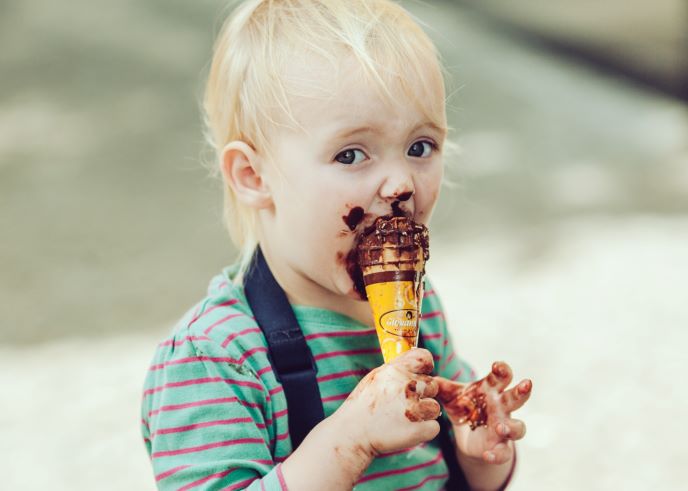Do toddler table manners matter, or is it more important that they just eat something? And what about playing with their food, is this allowed?
I wrote a post for the team at the hotteaworkshop.com recently all about sitting at the table and why it is important for young children to sit well to be able to eat well. You can read the post here. (Yes, they should. It has to do with swallowing. And role modelling.)
The post generated lots of questions from readers about toddler table manners. What should be allowed at the dinner table, and what shouldn’t. And how do you reconcile table manners with toddlers experiencing the sensory properties of food and becoming familiar with new foods in a way that feels safe to them?
These questions got me thinking about possible answers to these questions. I have summarised my thoughts into two broad areas or ways of thinking about toddler table manners:
- Behaviours that you are just going to have to learn to live with if you want to raise a happy eater, however ANNOYING (or just downright odd),
- Behaviours that you probably shouldn’t allow, and what to do instead.
5 behaviours that you are just going to have to learn to live with if you want to raise a happy eater
Some things toddlers do with their food are just plain weird (or cute, depends on how you look at it. I always think it’s cute when I see a toddler exploring food, but that goes with the territory.) It may nonetheless help to understand the evolutionary background to some of these behaviours and then they might seem a little less strange.
Toddlers are designed to become a bit wary of new foods round about 20 months old. You’ve probably heard this before: it’s called food ‘neophobia’.
Food neophobia is nature’s clever design to prevent toddlers, who are just learning to walk and explore the world, from eating potentially poisonous foods until they have learnt what is safe to eat[i]. This suspicion of the new may even extend to familiar and previously enjoyed foods, especially if they are presented in new ways, with unknown foods, or under unfamiliar circumstances.
Toddlers learn what is safe to eat by experience and by observing others. If the experience and the after-affects of eating a particular food are pleasant, your toddler will start to learn to like this new food. If they are negative, if she is forced to eat or chastised, her experience may be negative instead.
1. Food not touching on the plate
Many parents tell me that their child doesn’t like foods touching, whether on the plate or even in a sandwich. Parents often find this puzzling. Why does food touching worry my child?

It’s easy to understand why a child might not like food touching if we look at it from an evolutionary perspective. Research has shown that we will reject food that we know, or think, has been contaminated by something we think of as disgusting.
This is often the case even if the bit we are eating cannot possibly be contaminated[ii]. For example, if you saw a cockroach run over one half of your plate and then run off, you wouldn’t want to eat the food on the other side of the plate, even if you knew that the food on that side of the plate couldn’t possibly be contaminated by the cockroach.
Research conducted by Steven Brown and colleagues at the University of Aberdeen has confirmed what parents of toddlers already know: when a portion of new food is presented alongside a disliked food, and the two foods touch, the disliked food “contaminates” the food that they already like[iii]. The children in this research were also less likely to try the food that they already liked when it had been in contact with a disliked food.
A new food, or a food that she is still unsure about, is a little bit like the side of the plate the cockroach has not been on. Until your child becomes familiar with and learns to like the new food, all the food on the plate might be contaminated; she might find it just as disgusting as food that has been walked over by a cockroach.
The best thing to do is to simply ignore this behaviour. If parents don’t pay attention to this odd habit, it usually disappears (providing your child has plenty of opportunities to see adults and other children happily combining foods).
If your child doesn’t like his food touching, don’t serve new foods touching others on the plate – it is quite likely that he will then reject food he was previously happy to eat.
2. Nibbling at food
You may have noticed that children often take a tiny nibble of a new food before deciding whether or not to eat any more. This is often accompanied by a lot of looking around, to observe the reaction of others. In fact, many adults do this too when trying something new.
Humans – adult and children – study the people around them for clues: “Are they eating it? Do they seem to enjoy it, which means it must be good? Or are they making a disgusted face, which tells me it must be bad?”

Many studies into food aversion have been conducted using rats. Like humans, rats lack much in the way of instinct telling them what to eat and what to avoid, in the same way as humans do (lions, for example, are never going to try a banana). Because rats, like humans, are able to survive on a wide range of different foods, they have to learn what is good to eat and what makes them ill.
Rats do this by taking a small bite of a new kind of food and waiting to see what happens. If it makes them ill, they will avoid that food in the future. (This is what makes poisoning rats so hard, a phenomenon known as “bait shyness” – rats soon learn to avoid a poisoned food that makes them ill.)
Plenty of other animal species also take a small bite and wait to see what happens.[iv]
This tells us that this behaviour, taking a nibble of a new food, does happen for a reason, even if it might seem odd to an adult who knows exactly what to expect in terms of taste and texture from most foods you will experience in a day. You have many years of experience trying and learning about new foods – your child is just starting out on this adventure.
3. Grimacing
Young children are just learning how to control their facial expressions in a socially acceptable way (hey, I know adults unable to control their grimacing at my cooking!).
Just don’t focus on it; or else she may learn that gurning is an excellent way to get your full attention at a mealtime, rather than practising her eating and toddler table manners.
4. Spitting food out or ‘mouthing’
Another example of a child’s behaviour to ignore is “mouthing”. Mouthing is when a young child puts food in her mouth and takes it out again. Sometimes a child will even chew the food and take it out.
Toddlers may “mouth” a new food many times while they get used to the flavour and the texture.
Young children learn to like new tastes, flavours and textures by trying them out. Tasting the food makes it more familiar. With every attempt at tasting new food, often over several meals or snacks, the food becomes more familiar. When it is more familiar, there is a bigger chance that your child will learn to like it.
Try not to put pressure on your child to actually swallow the food while she is trying it out. Children eat better when they are not put under pressure to eat. It is perfectly OK for your child to experiment with an unfamiliar food by putting it in her mouth and taking it back out again.
By putting food in and taking it out, I mean politely removing the food and putting it back on her plate. I don’t mean spitting out, heaving up or making exaggerated yuk sounds, whining, crying or saying how disgusting it is. Teach your child to politely take food out and put it back on the plate if she doesn’t fancy swallowing it today.
There is even a technique called the ‘Tiny Tastes’ technique which encourages young children to take just an itsy taste of a new food without the pressure to eat it. It is thought that taking just a tiny taste, even without swallowing, gets a child used to this new type of food. The technique was developed by Dr Lucy Cooke, a psychologist in London who specialises in child feeding. She led a research project (also called Tiny Tastes), which was shown to be very successful at encouraging young children who were picky eaters to try just one little bite. You can read more about it here.
5. Eating with their hands
Don’t worry too much about using cutlery correctly when they are very young. Toddler table manners with cutlery will come later – she will soon learn by watching the adults and any older siblings. Just carry on using your own cutlery and, once your child has become familiar and comfortable with the new food, she will usually follow your lead and try and copy you. She will take great pride in being able to eat like the adults, so don’t tell her off if she doesn’t get it right to start with.

When a child is a picky eater, one of the key sensations she must get used to is the feeling of food. This helps her to become familiar with new food and learn that it poses no threat. By feeling the texture of unfamiliar food in her hands, she may anticipate what this new food will feel like when eaten. If your child is sensitive to the feel of food on their fingers, be sure to have some wipes or plenty of kitchen roll handy; just don’t rush to wipe her clean if she doesn’t need you to.
Expect spills and mess!
And 4 behaviours that you probably shouldn’t allow, and what to do instead
As a general rule, you might want to ignore any behaviour that you don’t want to see more of. But do keep in mind that some behaviours, while not acceptable for older children and adults, are part of the normal development of younger children as they learn to eat.
Often, they are just working out how to manage a new food. This includes behaviours such as pushing food around the plate, mashing it up, and otherwise playing with it. Think of it as practice.
1. Demanding attention at the dinner table with food refusal
Young children are still learning about social responses. Many, if not most, of these responses developed in humans to enable us to live effectively in a group. Social niceties and reciprocity maximise our potential for survival.
In contrast, children would have needed to keep the constant attention of their caregivers in order to maximise their potential for survival. This would have been particularly relevant when resources were scarce, and there were many young mouths to feed and youngsters to take care of.
Constantly being within the attention span of caregivers (parents and other family members) means that children are more likely to survive.
Demanding attention and protection are survival mechanisms.

Young children will often try and keep your constant attention. This includes at the dinner table, and particularly if a child is ‘competing’ with siblings or other children. Food refusal is often a very effective way of getting your attention, precisely because we are designed to worry so much about it.
Food refusal and other childish eating behaviours (like pushing food around, chewing and chewing and chewing, and spitting out) get us focused on the child demonstrating them.
As hard as it may be, try to ignore these behaviours. Don’t ignore the child, just the behaviour. Keep chatting, keep the mealtime pleasant. You could chat about the day, school, playgroup, what Granny said, what you’re going to do later, their new friend or toy.
Another good way of allowing your child some control at mealtimes is by allowing her to help herself at the table. She can even practice her toddler table manners by serving others.
Many years ago I lived and studied in Greece, where families tended to eat together more often, sharing from the table (at least back then).
It is a great shame that we it is less common for us to bring food to the table for everyone to help themselves, instead of relying so heavily on pre-determined portion sizes. It takes away our ability to judge how much to put on our plate based on our appetite; instead, we rely on a food producer to tell us how much to eat, which can leave us overstuffed or unsatisfied.
So, bring back the centre dishes! With a little help, your child will take great pride in dishing out as much as she wants before handing it on.
2. Getting up and down from the table or eating while walking or moving around
Children should sit, and stay seated, at the dinner table for as long as they are eating.

Toddler table manners side, this is important for their safety. Young children are still learning how to eat and this is an important task that needs their full attention. If children are on the move while eating or not seated upright, there is a greater risk that they may accidentally choke on a food item.
At the same time, don’t make your child sit at the dinner table for the length of an adult meal. 20 to 30 minutes is enough, even less for a snack. Once your child is finished with her meal or snack, let her get down. Don’t make a child stay at the table for a long time in the hope that she will eat more – she won’t. Children have a short attention span, and forcing their presence just makes mealtimes unpleasant.
3. Technology at the table
Generally, children eat less well when they are distracted by TV, mobile phones, games, etc.
Although adults may eat more when we are distracted (so-called “mindless eating”), children tend to eat less well. This is because they are still learning the skills of eating and need to concentrate on what they are doing.
There are some exceptions to this. Some children with sensory processing issues or a more serious case of food avoidance (Avoidant Restrictive Food Intake Disorder, or ARFID for short) may eat better with distractions, but this will not help most children.
For most children it is better if they focus on eating at meals and snacks in the company of role models. In this way, they learn to savour and enjoy food and mealtimes, how to behave at the table and how to listen to their appetite cues telling them when they have had enough. Turning toddler table manners into good eating habits for life!
4. Fidgeting at the table
This might be a sign that your child isn’t sitting well. Children need to be seated well to eat well – this helps with swallowing. When the pelvis is in a neutral position it supports the head. When the head is supported by the trunk, the tongue and jaw muscles aren’t needed for support – and can instead be used for eating and drinking.
To make sure your child is seated well for eating and drinking, consider the following:
- Make sure your child is seated with 90 degrees at the hips, 90 degrees at the knees and 90 degrees at the ankles. Get down and have a look to see how your child is seated. Use a booster seat if necessary.
- Make sure her feet are supported. This is needed for core stability, which in turn is needed for jaw stability. Jaw stability is needed for tongue movement, chewing, and swallowing. It can also help stability if your child has her arms resting on the arms of a chair.
- Avoid “W” legs: when your child sits down with her feet pointing out to the side. A variation of this is wrapping her feet around the chair legs. Children and adults do this when core tone is low, as it provides more stability. Ideally, it is much better to practise upright sitting with her knees and ankles at 90 degrees. This allows better tone to develop, which means she no longer needs to grasp the chair legs with her feet for core support.
- Poor tone can lead a child to slide down in her seat. This affects head positioning and therefore also jaw stability, which in turn affects tongue movement.
- Poor posture can make a child wriggle at mealtimes. This is because she is trying to sit up and stay supported. This means she is focusing less on food and eating. It also makes the whole mealtime experience less pleasurable, both for your child and for you!
Do you have any thoughts on toddler table manners?
Do you have any funny stories to tell? I saw this incredibly cute video on Facebook with a little lad, probably 14 months, scraping ice-cream off a cone with his foot and licking his feet – sensory weaning at it’s best!
Comment below and share with the rest of us.

Disclaimer: As always, the contents of this blog post apply to typically developing children who are not receiving medical or other healthcare professional treatment for eating or feeding difficulties. The content of this blog post is for informational purposes only and does not constitute medical or nutritional advice. If you are worried about your child’s eating, swallowing or posture while eating, then you should seek the advice of your child’s medical practitioner and ask if a referral to a Speech and Language Therapist/ Pathologist and/or an Occupational Therapist is required.
[i] Lafraire, J., Rioux, C., Giboreau, A., Picard, D. (2016). Food rejections in children: Cognitive and social/environmental factors involved in food neophobia and picky/fussy eating behavior. Appetite. 96, 347-357.
[ii] Rozin, P. and Fallon, A.E. (1987). A perspective on disgust. Psychological Review. 94(1), 23-41.
[iii] Brown, S.D., Harris, G., Bell, L., Lines, L.M. (2012). Disliked food acting as a contaminant in a sample of young children. Appetite. 58(3), 991-6.
[iv] Addessi, E., Visalberghi, E. (2006). How social influences affect food neophobia in captive chimpanzees: a comparative approach. In: Matsuzawa, T., Tomonaga, M., Tanaka, M., eds. Cognitive Development in Chimpanzees. Tokyo: Springer-Verlag, 246-264.




